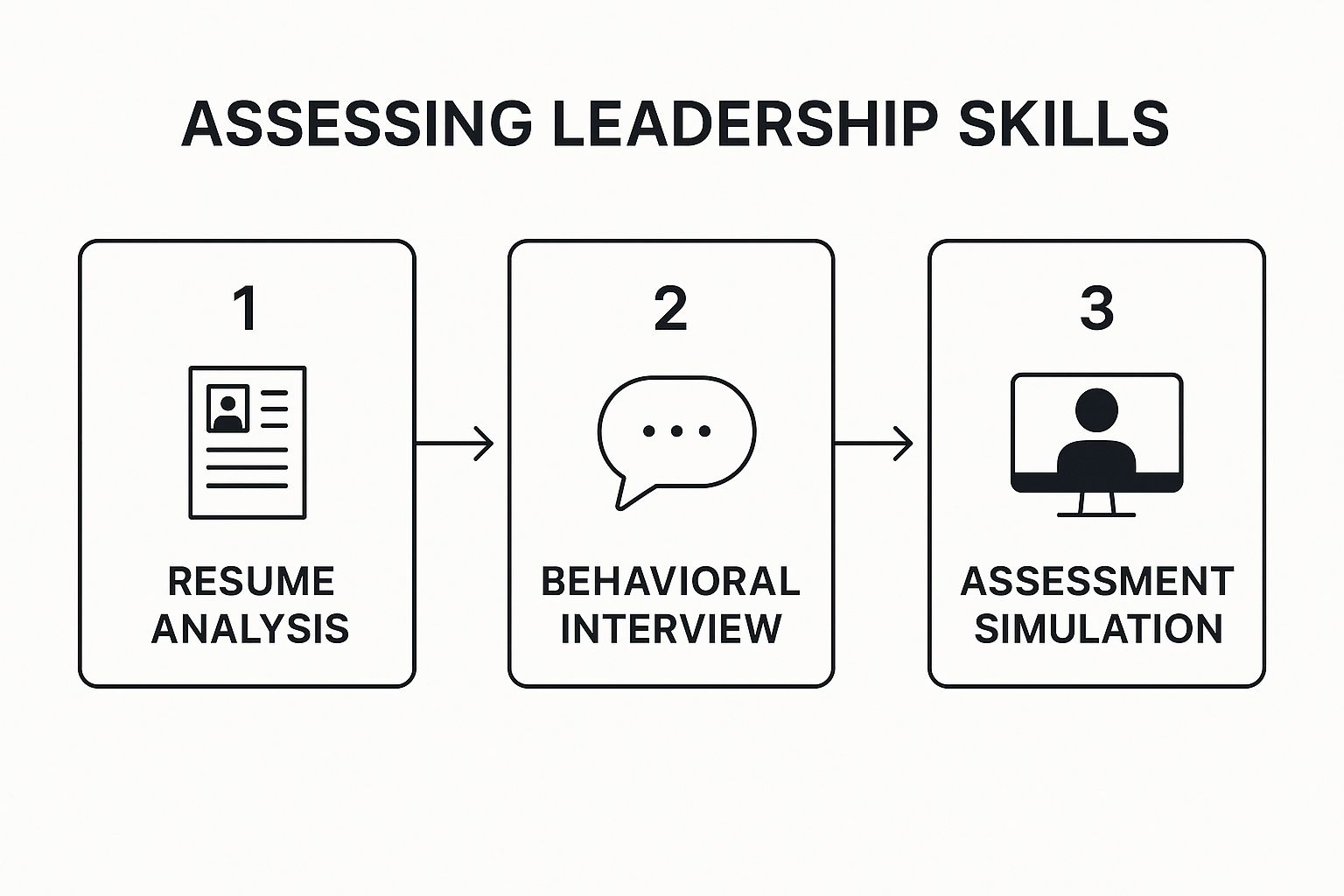Leadership hiring is much more than just filling a senior-level vacancy; it’s the strategic act of choosing an architect for your company’s future. The right leader can design a blueprint for growth, innovation, and resilience. On the other hand, a poor choice can create foundational cracks that threaten the entire structure.
This process is arguably the single most impactful lever you have for shaping your company’s culture and securing a long-term competitive edge.
Why Strategic Leadership Hiring Defines Company Success

Recruiting an executive is fundamentally different from standard talent acquisition. While most roles are hired to support the company’s existing engine, a leadership hire is often tasked with rebuilding, upgrading, or charting a completely new course for that engine.
Their decisions create a powerful ripple effect that touches every single department and employee. This is why it has to be treated as a core business strategy, not just another HR function. A single strategic hire can unlock new market opportunities, revitalise a stagnant culture, and drive performance improvements across the board.
Conversely, a mis-hire at this level is a catastrophe, often costing millions in lost revenue, plummeting morale, and strategic misdirection.
The True Impact of a C-Suite Hire
The influence of a new leader extends far beyond their direct reports. Their vision, values, and operational style quickly become embedded in the organisation’s DNA.
Think about the key areas they shape from day one:
- Organisational Culture: Leaders are the ones who set the real tone for communication, collaboration, and accountability—not posters on a wall.
- Business Performance: Their strategic choices directly impact revenue, profitability, and your standing in the market.
- Innovation and Agility: A forward-thinking leader encourages the kind of experimentation and adaptability needed to stay relevant.
- Talent Magnetism: Top-tier executives are magnets for other high-performing individuals. Great people want to work for great leaders.
A landmark study found that companies with top-quartile leadership teams outperform their peers with a 2x greater return to shareholders. This shows the undeniable financial link between the quality of your executives and your business success.
Ultimately, the best workplaces are no accident; they are the direct result of visionary leadership that aligns people with a powerful purpose.
This is exactly why investing time and resources into a meticulous leadership hiring process isn’t an expense. It’s a critical investment in your company’s long-term viability. The goal isn’t just to fill a seat—it’s to secure a future.
The Shifting Sands of Executive Leadership
The classic image of an executive leader is changing, and fast. Successful leadership hiring today isn’t about finding a seasoned generalist who can do a bit of everything. It’s about finding sharp specialists who can cut through the noise in complex, fast-moving industries. The demand for leaders isn’t just growing—it’s shifting toward specific, high-impact roles that reflect our new economic realities.
We’re seeing a clear move away from the traditional, one-size-fits-all C-suite. Instead, companies are aggressively hunting for functional heads with deep, almost obsessive, expertise in one area. This is a direct reaction to market pressures that demand nothing less than excellence in key business functions, from managing talent to driving revenue.
And the numbers back this up. In fiscal year 2025, India saw a 9.5% year-on-year jump in top leadership appointments. The most sought-after roles? Functional heads in HR and sales/marketing, which made up 31% and 29% of these hires, respectively. This tells you exactly where companies are placing their strategic bets. You can get more details on this executive hiring surge from The Economic Times.
New Industries Need New Playbooks
It’s not just about functional specialisation. The explosion of entirely new industries is creating a need for a completely different breed of executive. Think about the massive growth in sectors like renewable energy and electric vehicles (EVs). These aren’t just new branches on an old tree; they’re entirely new ecosystems that need visionary leaders who can write the playbook from scratch.
Take a leader for an EV manufacturing firm. They need much more than just a background in the automotive world. Their expertise has to cover:
- Battery Technology: Knowing how to navigate tangled supply chains and cutting-edge R&D.
- Software Integration: Understanding that the modern vehicle is a computer on wheels.
- Charging Infrastructure: Having the vision to build out the network that makes their products viable.
This demands a rare mix of industrial know-how, tech fluency, and strategic foresight—a combination that’s incredibly difficult to find and commands a premium.
Another powerful force at play is the professionalisation of family-run businesses. As these companies scale up and look for outside investment, they need seasoned executives who can introduce structured processes, guarantee good governance, and drive growth that goes beyond the founding family’s original vision.
The Economic Forces Remodelling the C-Suite
This whole evolution is being driven by powerful economic currents. Massive new capital projects and a flood of private equity investment are pumping money and huge expectations into the market. Investors are demanding sophisticated leaders who can deliver strong, measurable returns, pushing companies to upgrade their C-suite with proven, data-driven executives.
For a CHRO, this new landscape is both a challenge and a massive opportunity. The trick is to look past the job that’s open today and start thinking about the leadership skills your company will need three to five years from now. Aligning your leadership hiring strategy with these bigger economic trends isn’t just a good idea anymore—it’s absolutely critical for staying competitive in a market that never stops changing.
Common Leadership Hiring Pitfalls and How to Avoid Them
Even the most experienced CHROs can see an executive search go off the rails because of a few common, yet critical, missteps. The stakes in leadership hiring are incredibly high. A small oversight can easily lead to a costly mis-hire, setting the organisation back months, if not years. The key is to anticipate these traps before you fall into them.
One of the most frequent errors is relying too heavily on unstructured interviews and simple “gut feelings.” While intuition can play a part, it’s a notoriously unreliable predictor of long-term success. This approach often ends with hiring someone who is charming and charismatic in an interview but simply lacks the core competencies to deliver results when it matters.
Another major pitfall is a slow, indecisive hiring process. Top-tier executive talent is always in high demand and won’t hang around waiting for a slow-moving committee to make up its mind. A drawn-out process signals disorganisation and is a surefire way to lose your ideal candidate to a more agile competitor.
Moving From Reactive to Proactive Hiring
To sidestep these issues, you have to shift your mindset from being reactive to adopting a proactive, structured framework. This means establishing clear, objective criteria and processes before the search even begins, making sure every stakeholder is aligned from day one.
A powerful tool to combat vague requirements is the Success Scorecard. Instead of a generic job description, a scorecard details the specific, measurable outcomes the new leader must achieve in their first 12-18 months. It also clearly outlines the skills and cultural attributes needed to hit those goals. This document becomes the north star for the entire search.
A mis-hire at the executive level can cost a company up to 213% of the employee’s salary. This figure doesn’t even account for the damage to team morale, lost opportunities, and strategic drift.
This statistic really drives home the immense financial and cultural risk of getting it wrong. The investment in building a structured process is minor compared to the devastating cost of a poor leadership decision.
To give a clearer picture, let’s look at how these common mistakes stack up against more strategic solutions.
Common Pitfalls vs Proactive Solutions
| Common Pitfall | Potential Impact | Proactive Solution |
|---|---|---|
| Vague job description | Attracts wrong-fit candidates; misaligned evaluation | Develop a Success Scorecard with clear outcomes |
| “Gut feel” interviews | High risk of bias; poor predictor of performance | Implement structured, competency-based panel interviews |
| Slow, indecisive process | Top candidates accept competing offers | Establish a clear timeline and decision-making process upfront |
| Poor culture fit assessment | Hires disrupt team cohesion and productivity | Define cultural values and use behavioural questions to assess alignment |
| Superficial reference checks | Missed red flags; unverified claims | Conduct deep, structured reference checks focused on scorecard competencies |
This table shows how a few deliberate changes can transform a high-risk process into a reliable, strategic function.
Building a Defensible Hiring Process
Creating a more robust process involves several key strategic shifts. Each one is designed to replace subjectivity with objective evidence and ensure a consistent, fair evaluation for every single candidate.
Here are three essential adjustments to make:
1. Implement Competency-Based Panels: Swap out casual one-on-one chats for structured panel interviews. Each interviewer should be assigned specific competencies to evaluate, using behavioural questions that require candidates to provide concrete examples from their past.
2. Define and Assess Cultural Alignment: “Culture fit” is often mistaken for hiring people who think and act just like everyone else. The real goal is to align on core values and work ethics. You can explore our guide on the best practices for assessing and hiring for culture fit to build a more intentional approach.
3. Conduct Deep Reference Checks: Go beyond just confirming dates of employment. Use structured reference checks to validate the candidate’s achievements and competencies as defined in your scorecard. Ask their former colleagues and managers to describe specific situations where the candidate demonstrated key leadership traits.
By adopting these proactive measures, you transform your leadership hiring from a game of chance into a strategic, data-informed discipline. This new approach will equip you to make confident decisions that secure the right leaders to drive your organisation’s future success.
Spotting the DNA of a Modern Leader
A stellar resume and a long list of experiences? That’s just the ticket to the game, not the way to win it. In today’s C-suite, what got a leader to the top yesterday won’t guarantee they stay there tomorrow. Effective leadership hiring means we have to dig much deeper, looking for the specific, modern qualities that allow an executive to navigate a world that’s constantly in flux.
The old playbook of matching years of experience to a job description is officially obsolete. The real focus has to be on a candidate’s fundamental ability to handle disruption. It’s about finding that unique blend of attributes that prepares them not just for the challenges we see today, but for the curveballs that are inevitably coming our way. A truly future-ready executive is defined by their adaptability and their foresight.
The Non-Negotiables for Today’s Executive
Certain traits are no longer just “nice-to-haves”. They have become hard requirements for anyone tasked with steering an organisation through the maze of technological shifts and geopolitical instability. Think of these less as soft skills and more as survival skills.
Your assessment process needs to be laser-focused on finding concrete evidence of:
- Digital Fluency: This is so much more than just being tech-savvy. It’s the ability to see how emerging technologies like AI can be woven into the business fabric to create real value and a sharp competitive edge.
- Unwavering Resilience: Let’s be honest, modern leaders are in a constant state of crisis management. The capacity to stay calm, make clear-headed decisions under immense pressure, and guide a team through the storm is absolutely mission-critical.
- A Global Mindset: Markets are more tangled together than ever. A leader needs a sophisticated understanding of different cultures, economic drivers, and global business practices to steer expansion or manage international teams effectively.
- Deep Expertise in Governance: A rock-solid commitment to strong corporate governance, risk management, and ethical oversight isn’t just about compliance; it’s the bedrock of investor confidence and long-term stability.
How to Assess What Isn’t on the Resume
Pinpointing these traits means you have to throw out the standard interview script. You need to create situations that compel candidates to show you what they’re made of, not just tell you.
A leader’s true calibre is revealed not when things are going well, but in how they respond when everything is going wrong. Your hiring process must simulate this pressure to get an accurate picture of their resilience and decision-making skills.
This hands-on approach shifts the entire dynamic. It moves the conversation from what a candidate claims they can do to what they can actually prove they can do.
The intense global challenges of the past few years have only put this need into overdrive. The cocktail of geopolitical tension and supply chain chaos has pushed resilience right to the top of the priority list. As a result, we’re seeing a huge surge in demand for tech-focused roles like Chief Digital Officers. We’re also seeing a premium placed on executives with serious international exposure, as Indian companies push their boundaries globally and multinationals double down on their presence here. You can discover more insights about these leadership hiring trends on PromptPersonnel.com.
To get the full picture, you need to attack the evaluation from multiple angles:
1. Behavioural Questions: Don’t just ask if they’re resilient. Ask for specific stories where they had to be. “Tell me about a time you led through a major crisis.”
2. Scenario Challenges: Give them a real-world business problem your company is facing (or could face) and ask them to walk you through their strategic response.
3. Deep-Dive Reference Checks: Go way beyond just confirming dates of employment. Ask their former colleagues to describe exactly how the candidate handled that massive project failure or led that critical digital transformation.
A Strategic Framework for Leadership Hiring
Executing a world-class executive search can feel like a massive, unstructured undertaking. But it doesn’t have to be. A solid framework turns this complex journey into a manageable and, more importantly, a repeatable playbook. Exceptional leadership hiring isn’t about getting lucky; it’s about a disciplined process that guides you from a high-level vision all the way to a successful onboarding.
This journey starts not with a job description, but with a foundational conversation about the future. Before you even think about potential candidates, you need to align completely with the board and key stakeholders. What does this role truly need to accomplish over the next three to five years to propel the business forward?
Defining the Mandate and Building the Scorecard
Once you’ve locked in that long-term vision, the next step is to translate it into a detailed Success Scorecard. This is far more powerful than a typical job description. It clearly defines the specific, measurable outcomes you expect from the new leader within their first 18 months and lays out the core competencies and cultural DNA needed to get there.
This scorecard becomes your North Star. It’s the objective benchmark you’ll use to measure every single candidate, stripping away the subjectivity and “gut feelings” that so often derail executive searches. Everyone involved in the hiring decision is now assessing candidates against the exact same criteria, which brings much-needed consistency and clarity to the process.
A well-defined scorecard is the single most important tool in an executive search. It forces alignment, clarifies expectations, and provides a data-driven foundation for a defensible hiring decision.
Proactive Sourcing and Rigorous Assessment
With a crystal-clear mandate in hand, your search can shift from passive to proactive. Let’s be honest: relying on job boards for leadership roles is a recipe for mediocrity. The best candidates—the true game-changers—are rarely looking for a job. They need to be found through deep networking, strategic industry mapping, and highly targeted outreach.
This effort builds a strong pool of high-potential individuals who then move into a rigorous, multi-layered assessment process. This is where your scorecard truly shines, guiding each stage of the evaluation to create a holistic picture of every candidate’s capabilities. For organisations looking to scale this function, it’s worth exploring how recruitment process outsourcing can help in high-impact hiring to leverage external expertise for data-driven results.
The flow below shows a typical assessment designed to progressively deepen the evaluation at each step.

This structured sequence ensures you’re building a complete profile of a candidate, moving beyond their documented history to see their real-world problem-solving abilities in action.
Crafting the Offer and Ensuring a Smooth Transition
The final stage is about more than just numbers on a page. It’s about crafting a compelling offer that genuinely speaks to the candidate’s personal motivations and career ambitions. This requires a deep understanding of what drives them, something you should have gathered throughout the interview process.
Once the offer is accepted, the framework doesn’t just stop. It extends into a structured onboarding plan designed to set the new leader up for immediate impact and long-term success. This entire end-to-end process ensures your leadership hiring efforts are strategic, consistent, and ultimately, effective.
Strengthening Governance Through C-Suite Appointments

Smart leadership hiring is about so much more than just filling a vacant spot on the org chart. It’s one of the most powerful moves you can make to strengthen your company’s strategic core. In today’s increasingly tricky business world, every C-suite appointment sends a clear message about your commitment to solid governance and long-term stability.
When you start looking at executive recruitment this way, the whole game changes. You’re no longer just hunting for a skilled manager; you’re searching for a true steward of the company’s future. This means putting a premium on candidates who have a proven history of managing risk, championing ethical oversight, and thinking ten steps ahead. These are the kinds of leaders who directly boost investor confidence and build a more resilient organisation from the top down.
This shift towards governance isn’t just a theory; the numbers back it up. The Indian CXO hiring market saw a 9.5% jump in FY25, and what’s really telling is that over half of these were board-level roles. This isn’t a coincidence. It shows a deliberate strategy by companies to bring in leaders with serious governance chops to tighten up strategic oversight. You can discover more insights about these CXO hiring trends from SilverPeople.
GCCs and the Drive for Digital Transformation
This strategic focus is especially vital for India’s Global Capability Centres (GCCs). As these centres grow from being simple cost-saving hubs to full-blown innovation engines, they need leaders who can steer complex digital projects while keeping a firm hand on governance.
The right leader in a GCC can be the difference between a simple back-office operation and a strategic global partner. Their job is to weave governance into the very fabric of digital innovation.
When hiring for these pivotal roles, you have to find people who can balance speed with responsibility. They need to be champions for new technology and better processes, but they also have to ensure every move aligns with global compliance and risk management rules. Getting this balance right is the key to making sure rapid growth is built on a foundation that’s secure and built to last.
At Taggd, we specialise in Recruitment Process Outsourcing that builds world-class leadership teams. Discover how our strategic approach can help you secure the right leaders to drive your organisation forward.









